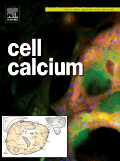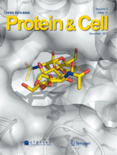
JOURNAL OF CELL SCIENCE
Scope & Guideline
Connecting researchers to the heartbeat of cell science.
Introduction
Aims and Scopes
- Cellular Mechanisms and Signaling:
The journal emphasizes studies exploring the fundamental cellular mechanisms, such as signaling pathways, cytoskeletal dynamics, and intracellular transport, which are crucial for maintaining cellular function and responding to environmental changes. - Cellular Structure and Dynamics:
Research on the structural aspects of cells, including organelle organization, cytoskeletal architecture, and membrane dynamics, is a core focus, contributing to a deeper understanding of how cellular structures support their functions. - Development and Differentiation:
The journal covers studies on cell differentiation, development, and the roles of various cell types in multicellular organisms, providing insights into developmental biology and regenerative medicine. - Cell Interactions and Microenvironment:
Papers exploring cell-cell interactions, tissue mechanics, and the influence of the extracellular matrix on cellular behavior are prominent, highlighting the importance of the cellular microenvironment. - Disease Mechanisms and Therapeutics:
The journal also addresses the role of cellular processes in disease, particularly cancer and neurodegenerative disorders, and explores potential therapeutic interventions.
Trending and Emerging
- Mechanobiology and Cellular Mechanics:
There is an increasing focus on the role of mechanical forces in cell behavior, emphasizing how physical properties of the cellular environment influence processes such as migration, differentiation, and tissue development. - Cellular Responses to Stress and Damage:
Research exploring how cells respond to various stressors, including oxidative stress and damage, has gained traction, highlighting the importance of cellular resilience and repair mechanisms. - Intercellular Communication and Extracellular Vesicles:
Studies on the mechanisms of intercellular communication, particularly through extracellular vesicles, are on the rise, reflecting an interest in how cells communicate and influence each other's behavior. - Integration of AI and Computational Biology:
The integration of artificial intelligence and computational methods in analyzing biological data, including imaging and omics data, is a growing trend, enhancing the understanding of complex cellular processes. - Therapeutic Targeting of Cellular Pathways:
An emphasis on identifying and targeting specific cellular pathways for therapeutic purposes, particularly in cancer and metabolic diseases, is emerging as a significant theme in recent publications.
Declining or Waning
- Classical Cell Biology Techniques:
There has been a noticeable decrease in papers focusing solely on classical cell biology techniques, such as basic microscopy and standard biochemical assays, as researchers increasingly adopt more advanced imaging and molecular techniques. - Single-Cell Studies:
The volume of research centered on single-cell analyses has waned, possibly overshadowed by the rise of high-throughput technologies that analyze cell populations rather than individual cells. - Basic Mechanistic Studies:
Papers that focus primarily on basic mechanistic studies without clear applications or implications for broader biological contexts have become less common, as there is a growing emphasis on translational research.
Similar Journals

CELL CALCIUM
Exploring Calcium's Impact on Health and DiseaseCELL CALCIUM is a premier journal published by ELSEVIER SCI LTD, focusing on the critical role of calcium in cellular processes, making it an essential read for researchers and professionals in the fields of Cell Biology, Molecular Biology, and Physiology. Having been in publication since 1980, this journal is well-regarded, holding a Q2 ranking in Cell Biology and Molecular Biology, as well as a prestigious Q1 status in Physiology for 2023. With an impressive Scopus ranking that places it in the top 20% of journals in its categories, CELL CALCIUM aims to disseminate original research articles that advance the understanding of calcium signaling mechanisms and their implications in health and disease. Although not available via open access, its insights are critical for advancing knowledge and fostering collaboration within the scientific community. The journal is located in the United Kingdom, with its editorial excellence helping to promote high-impact research that continues to influence both academia and industry.

CURRENT OPINION IN CELL BIOLOGY
Advancing Insights in Cellular MechanismsCURRENT OPINION IN CELL BIOLOGY, published by CURRENT BIOLOGY LTD, serves as a vital resource for scholars and professionals in the dynamic field of cell biology. With a solid Q1 ranking and impressive Scopus ranking of #33 out of 285 in the category of Cell Biology, this journal is recognized for its high impact and relevance among its peers, boasting an excellent percentile ranking of 88th. Established in 1989, it provides insightful reviews and perspectives that capture the latest developments and emergent trends in cellular research, making it indispensable for those aiming to deepen their understanding of cellular mechanisms and innovations. While the journal does not offer open access, its carefully curated content ensures that subscribers receive top-tier scholarly discourse. Situated in the heart of the United Kingdom, CURRENT OPINION IN CELL BIOLOGY continues to shape the conversation in a field that is critical to advancements in biochemistry, genetics, and molecular biology.

Protein & Cell
Shaping the Future of Scientific Collaboration and DiscussionProtein & Cell, published by Oxford University Press, is a distinguished international journal focusing on cutting-edge research in the fields of biochemistry, biotechnology, cell biology, and drug discovery. This open access journal, active since 2014, is dedicated to disseminating innovative findings that advance our understanding of protein functions and cellular processes, making it an essential resource for researchers, professionals, and students alike. With an impressive 2023 impact factor reflected in its Q1 ranking across multiple categories such as Biochemistry, Drug Discovery, and Cell Biology, 'Protein & Cell' stands at the forefront of scientific research, driving collaboration and discussion in the scientific community. Researchers can access the journal freely online, fostering a global exchange of knowledge and contributing to significant advancements in medicine and biotechnology. Located in the United Kingdom, the journal strives to be a pivotal platform for impactful research that influences future studies and applications.

CELL PROLIFERATION
Pioneering Research for a Healthier TomorrowCELL PROLIFERATION, published by Wiley, is a leading open-access journal that has been at the forefront of research since its inception in 1968. With an impact factor that solidifies its position in the Q1 category of both Cell Biology and Medicine (Miscellaneous), this journal serves as a premier platform for disseminating groundbreaking studies in the field of cellular and molecular biology. The journal is renowned for its rigorous peer-review process and comprehensive coverage of topics related to cell growth, division, and differentiation, making it an invaluable resource for researchers, professionals, and students alike. With its notable Scopus ranking of #30 in Biochemistry, Genetics, and Molecular Biology: Cell Biology, and a robust open access model since 2019, CELL PROLIFERATION ensures that cutting-edge research is accessible to a global audience, fostering collaboration and innovation across the scientific community. Located in the United Kingdom, the journal remains committed to enhancing the understanding of cellular processes, thereby influencing developments in medicine and biotechnology.

CELL RESEARCH
Exploring Innovations in Molecular BiologyCELL RESEARCH is a premier peer-reviewed journal dedicated to advancing the field of cell biology and molecular biology, published by SpringerNature. With an impressive impact factor and consistently ranking in the Q1 quartile for both cell biology and molecular biology, this journal serves as a pivotal resource for researchers, professionals, and students seeking to explore the latest discoveries and advancements in cellular mechanisms and their implications for health and disease. Since its inception in 1996, CELL RESEARCH has cultivated a distinguished reputation, currently boasting ranks in the top percentile of Scopus categories, reaffirming its influence and relevance to the scientific community. Although it is not an Open Access journal, its rigorous selection process ensures the publication of high-quality articles that contribute significantly to our understanding of life sciences. For those deeply engaged in the realms of biochemistry, genetics, and molecular biology, CELL RESEARCH is an essential conduit of innovative research and critical insights.

CELL STRUCTURE AND FUNCTION
Exploring the Intricacies of Cellular LifeCELL STRUCTURE AND FUNCTION is a distinguished open-access journal published by the Japan Society for Cell Biology, dedicated to advancing the field of cell biology and related disciplines. Since its inception in 1975, and now with open access available since 2017, the journal seeks to disseminate cutting-edge research and reviews that delve into the complexities of cellular structures and their functions. With a notable presence in various categories—ranked Q3 in Cell Biology and Molecular Biology and Q2 in Medicine (Miscellaneous) and Physiology as of 2023—this journal caters to a global audience of researchers, professionals, and students who are keen to explore the latest findings in cellular research. The efforts to foster accessibility and promote scholarly exchange in the field make CELL STRUCTURE AND FUNCTION an essential resource for those looking to stay at the forefront of biological sciences. The journal is indexed in Scopus, marking its relevance and reliability in the academic community. Explore the vast potential of cell biology through this comprehensive platform.

Cell Adhesion & Migration
Fostering Global Collaboration in Cell ScienceCell Adhesion & Migration, published by Taylor & Francis Inc, is a premier open access journal that has been providing a platform for the dissemination of high-quality research since its inception in 2007. With an emphasis on the critical roles that cell adhesion and migration play in various biological processes, this journal endeavors to publish cutting-edge studies in cell biology and cellular and molecular neuroscience. The journal's strong impact is reflected in its classification in the Q2 quartile for both Cell Biology and Cellular and Molecular Neuroscience categories as of 2023, underscoring its significance in advancing knowledge within the scientific community. The journal is accessible globally due to its open access model established in 2019, making it a valuable resource for researchers, professionals, and students aiming to explore innovative findings in cell dynamics and their implications in health and disease. With a commitment to fostering collaboration and dialogue among scientists, Cell Adhesion & Migration continues to be an essential resource in the rapidly evolving fields of cell biology and neuroscience.

Cell Regeneration
Advancing the Frontiers of Cellular DiscoveryCell Regeneration, published by SPRINGERNATURE, stands at the forefront of biological research, focusing on the dynamic field of cellular development and regenerative biology. Since its establishment in 2012, this journal has embraced an Open Access model, facilitating widespread dissemination of key findings and fostering collaboration among researchers in the Netherlands and beyond. With an impact factor underscoring its significance, Cell Regeneration is positioned in the Q2 category in both Cell Biology and Developmental Biology as of 2023, ranked #32 out of 82 and #170 out of 285 in relevant Scopus peer fields. The journal encompasses a broad spectrum of research that advances our understanding of cellular processes, offering vital insights into regenerative mechanisms and their applications in therapies. This robust platform not only serves as a valuable resource for researchers, professionals, and students but also encourages scholarly dialogue and innovation in the fast-evolving landscape of cell biology.

Frontiers in Cell and Developmental Biology
Innovating insights into cellular mechanisms and development.Frontiers in Cell and Developmental Biology is a leading open-access journal published by FRONTIERS MEDIA SA, dedicated to advancing the understanding of fundamental biological processes at the cellular and developmental levels. Since its inception in 2013, the journal has positioned itself as a cornerstone of research in its field, achieving esteemed Q1 quartile rankings in both Cell Biology and Developmental Biology for 2023. With a robust Scopus ranking of #13 out of 82 in Developmental Biology and #67 out of 285 in Cell Biology, it represents a vital platform for innovative research and scholarly discourse. The journal provides a comprehensive and accessible avenue for researchers, professionals, and students alike to share high-quality findings and insights into cellular mechanisms and developmental processes, fostering collaboration and knowledge exchange in the global scientific community. Based in Lausanne, Switzerland, Frontiers in Cell and Developmental Biology is committed to open science, ensuring that all articles are freely accessible to the public, thereby broadening the impact of research in the biological sciences.

DEVELOPMENTAL CELL
Illuminating the Dynamic Landscape of Cell BiologyDEVELOPMENTAL CELL, published by CELL PRESS, stands as a premier journal in the fields of Biochemistry, Genetics and Molecular Biology, Cell Biology, and Developmental Biology. With a significant influence evidenced by its Q1 rankings across several categories in 2023 and a remarkable Scopus ranking placing it at the 98th percentile for Developmental Biology, this journal is pivotal for researchers and academics aiming to advance their understanding of cellular processes. Covering a broad range of topics from molecular mechanisms to cellular developmental pathways, DEVELOPMENTAL CELL publishes cutting-edge research articles that contribute to the dynamic landscape of cell biology and related disciplines. Although it does not currently offer open access, the journal is accessible through institutional subscriptions, reinforcing its commitment to disseminating high-quality scientific knowledge produced by leading experts in the field. Based in the United States, DEVELOPMENTAL CELL continues to push the boundaries of discovery and innovation in life sciences, making it an essential resource for professionals, researchers, and students alike in the quest for foundational biological insights.